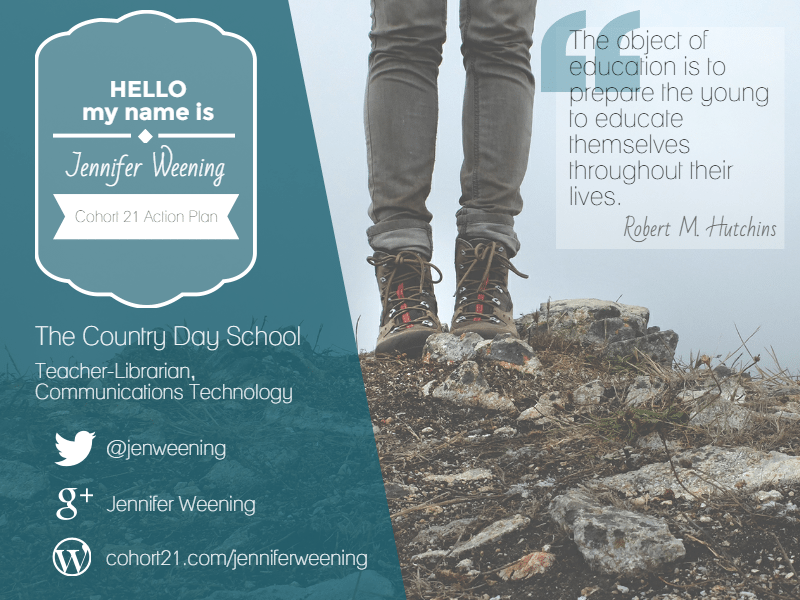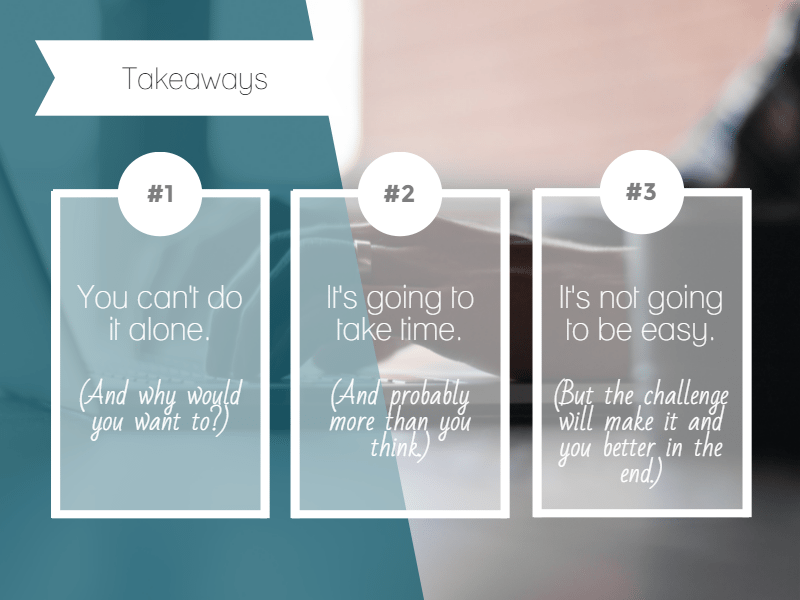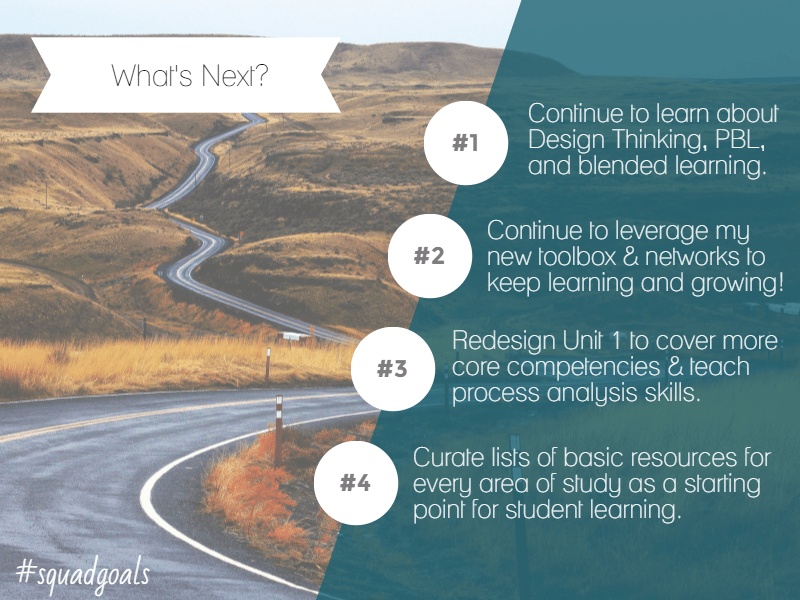When you break it down, my action plan can be summed up with this: Restructure Comm Tech to provide more and better opportunities for personalization and project-based learning.
It’s amazing how simple it can seem when you break it down to its essence, isn’t it? Even too obvious? And yet it’s incredible the amount of design thinking that went into realizing what was the right question to ask.

For my Action Plan blog post, I am going to elaborate on the points in my slide deck. (Having studied Presentation Zen with my class this year, I can’t bring myself to write paragraphs on my slide deck, and yet my ideas require some explanation.)
Takeaways
#1) You can’t do it alone (and why would you want to?)
Developing my professional network through Cohort 21 and on Twitter has been one of the single greatest parts of this experience for me. I’d heard over and over about developing a PLN and how it can be useful, but until I really learned how to use Twitter effectively, I had no idea how valuable it could be. I also learned that I really enjoyed blogging, and I can’t even begin to explain how excited I got every time I got a notification of a new comment! That feeling of being connected to other educators who are dedicated to improving their practice and who want to help you grow is a powerful thing.
#2) It’s going to take time (and probably more than you think.)
When you think big, you have to realize that you’re not going to be able to change everything instantaneously. I know that it is going to take me a couple of years to completely reorganize my course, and I recognize that it would be foolhardy to attempt massive changes without testing my ideas out on a smaller scale. That’s what this year has been for me: one of determining the problem that I want to solve, learning some strategies, ideas, and techniques for doing it, and trying out a new model of instruction. This summer, I will work on expanding that model, with the eventual goal of completely revamping my Comm Tech course. Baby steps!
#3) It’s not going to be easy (but the challenge will make it and you better in the end.)
This entire process has been super challenging, and finding the time to devote to it has been difficult. However, not once have I regretted taking the time to really reflect on my practice.
Trying out new instructional models in my classroom was not met with resounding applause, either. There were students who resisted taking responsibility for their learning, and who preferred for me to teach in the traditional manner. I don’t expect it to go totally smoothly as I continue to integrate design thinking, project-based learning and blended learning in my class, but I am confident that students will begin to see the value of it, and maybe even begin to embrace it! (A glimmer of hope: I spoke to a group of prospective students at our Academic Fair a couple of months ago and talked about my vision for the course: a structure wherein students would choose their interests and pursue them independently, curating resources along the way. A student came to me last week and told me that he’d already begun the process as he thinks the scope of the animation project he wants to do is bigger than he’ll be able to complete in a single school year!)
Next steps
#1) Continue to learn about Design Thinking, Project-based learning, and blended learning
I’m currently reading Creating Innovators by Tony Wagner and Graphic Design Thinking: Beyond Brainstorming by Ellen Lupton, and I have all sorts of articles on these topics bookmarked, waiting to be read. My summer reading list is a mile long!
#2) Continue to leverage my new toolbox and networks to keep learning and growing.
I plan to keep blogging about my teaching and learning. While my posts may not be as focussed on my Action Plan as they have been this year, I do love having a space to put my ideas and questions out there, so I won’t be logging off anytime soon.
#3) Redesign Unit 1 to cover more core competencies and teach basic technical skills.
As I mentioned in my last blog post (read it here if you missed it), my initial foray into independent learning yielded some good insights. I realized that there were several things that I needed to teach explicitly in order for students to be successful, so I plan to rewrite my first unit to incorporate more of those basic skills. Examples of these would include instruction on how to manage files, how to create a YouTube playlist, and some sort of activity that emphasizes the importance of following step-by-step instructions carefully. In order to really let students drive their own learning, I will also have to cover some more general technical skills in the first unit, as well. As an example, this year, we learned how to work our digital SLR cameras for taking photos in our photography unit, and we learned how to switch to video in our video production unit. I plan to incorporate basic technical aspects of the cameras, for both photography and video, in Unit 1 next year. That way, students will have a baseline toolkit that they will be able to draw upon whether they choose to focus on photography or video.
This year, I used a traditional test to assess students’ understanding of photography and camera basics. A practical, hands-on test to end the first unit would be a much more effective way to ensure students have the skills they need before moving on. (It was really ridiculous, actually. I had a question on the test: “Explain one of the three ways you can change your ISO on the camera.” Do I really care if they can explain it? Wouldn’t it be so much easier just to have them show me?!) I wonder if I was worried about not having a written record of students’ work to justify the grade they achieved. But looking back on it now, I can’t believe I thought that was a good test question!
#4) Curate lists of basic resources for every area of study as a starting point for student learning.
I want to be able to provide students with a starting point for each possible area of study. Chances are, not everyone will come to class on the first day knowing what elements of Comm Tech they want to pursue. Putting together a set of resources that students will be able to use to get a taste of the possibilities that await them will be one of my projects for this summer. And I can make it more fun for myself by trying out new ways of presenting those resources. Hyperdoc? YouTube video with cards? See more ideas here in Google’s Education Training Centre unit on Designing Interactive Curricula. The possibilities are endless!
Final Thoughts on the End of the Beginning
The Cohort 21 experience for me, this year, has been one of recognizing the value of going through these sometimes-challenging stages of questioning to arrive at the right questions. In so many ways, it was a version of what I want to see happening in my classroom – students discovering what they’re most interested in learning and solving, and then seeking out resources, support, and coaching to make it happen.
Never before have I spent so much time thinking about the challenges in my teaching and how to improve as a teacher. Like many others have mentioned in their final blog posts, I am not ready for this experience to be over and I am not going to let it end after April 22. This really is the end of the beginning for me. I’m not going anywhere and I hope that you will continue to follow my story here!
On my Action Plan presentation:
Huge thanks are due to @mrathier and @ecunningham whose beautiful Action Plan presentations (see Melissa’s here and see Emily’s here) inspired the design and format of my presentation. I loved Melissa’s use of an infographic style, which inspired me to try out Piktochart, and Emily’s simple format. Taking a cue from what I want my own students to do, I chose to learn something new rather than stick with what I already knew I could do easily. Lifelong learning, ftw!





@jweening I LOVE Presentation Zen too! I also love how you have brought that style into a Piktochart. It is the perfect marriage!
This is an excellent final reflection @jweening! Love the presentation and piktochart as well! You’ve really gotten deep into the reflection and have identified some solid foundations from which to grow. I couldn’t agree more that C21 is a model for how our classes could flow and it’s all about getting students used to a different style of learning where they don’t just sit and receive information.
This blog post will surely inspire many more from C21 for years to come! Well done!